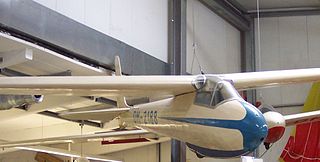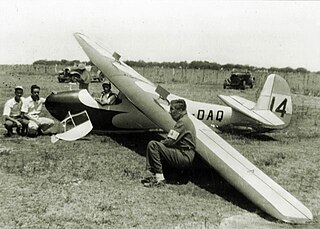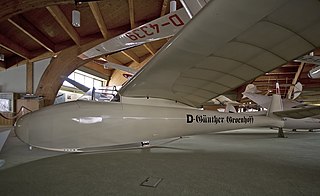Related Research Articles

The Deutsche Forschungsanstalt für Segelflug, or DFS, was formed in 1933 to centralise all gliding activity in Germany, under the directorship of Professor Walter Georgii. It was formed by the nationalisation of the Rhön-Rossitten Gesellschaft (RRG) at Darmstadt.

The DFS Olympia Meise was a German sailplane designed by the Deutsche Forschungsanstalt für Segelflug (DFS) for Olympic competition, based on the DFS Meise.
Contrary to the methods used by the Reich Air Ministry (RLM) for the allocation of aircraft designations, the designers and manufacturers of sailplanes and gliders in Germany enjoyed the freedom of choosing their own designations for their products up until 1945.

The DFS Habicht is an unlimited aerobatic sailplane that was designed in 1936 by Hans Jacobs with support provided by the Deutsche Forschungsanstalt für Segelflug. Four planes were made available for the Olympic Games of 1936, where the maneuvers of the Habicht over and literally inside the Olympic stadium enthralled spectators.
The Slingsby T.25 Gull 4 is a British glider designed and built by Slingsby that first flew in 1947.

The Eon Olympia was a glider produced from 1947 by Elliotts of Newbury.

The SZD-C Żuraw, also designated as IS-C is a two-seat training and aerobatic glider aircraft, built in Poland from 1952, a copy of the German DFS Kranich II.

The DFS Kranich is a type of German glider. It was developed by Hans Jacobs for the Deutsche Forschungsanstalt für Segelflug (DFS).

The DFS Weihe is a German single-seat, high-wing, 18 metre wingspan, high-performance glider that was designed by Hans Jacobs in 1937-38.
The DFS Seeadler was a German flying boat sailplane designed by Hans Jacobs of the Deutsche Forschungsanstalt für Segelflug (DFS). It was version of the 1935 DFS Rhönadler, with a new fuselage and strongly gulled wings to keep them clear from spray. The aircraft was first flown in the summer of 1935, test piloted by Hanna Reitsch, and towed by a Dornier Do 12.

The CVV-4 Pellicano was a single seat Italian glider designed for a competition to select an aircraft for the 1940 Olympic Games. The DFS Olympia Meise was preferred to it after the trials in Italy in 1939.

The DFS Rhönsperber, otherwise known as the Schweyer Rhönsperber or Jacobs Rhönsperber was a single seat competition glider designed in Germany by Hans Jacobs and first flown in 1935. For several years it was regarded as the best German sailplane and about one hundred were built.

The DFS Reiher was a single seat competition glider designed in Germany by Hans Jacobs and first flown in 1937. The type won the last two German Rhön gliding championships before the start of World War II. Six were factory produced.

The Schleicher Rhönbussard, otherwise known as the DFS Rhönbussard was intended as an intermediate glider trainer which could also fly competitively. It was designed by Hans Jacobs in Germany in the early 1930s. More than 200 were built.

The Schleicher Rhönadler, DFS Rhönadler or Jacobs Rhönadler is a high performance, single seat competition sailplane built in Germany in the 1930s. More than 65 were built.
The DFS Sperber Senior was a competition sailplane designed and built in Germany in 1936. During 1937 the sole example visited the United States and scored highest in the US National Soaring Competition.

The DFS Sperber Junior was a competition sailplane designed for Hanna Reitsch and built in Germany in 1936.

The German Glider Museum, situated on the Wasserkuppe in the German state of Hesse is the national gliding museum, opened in 1987.
References
- ↑ "Pioniere des Segelfluges: Hans Jacobs". Segelflugmuseum.de. 2007-02-10. Retrieved 2011-12-28.
- ↑ Simons, Martin (2006). Sailplanes 1920-1945 (2nd revised ed.). Königswinter: EQIP Werbung & Verlag GmbH. pp. 106–128. ISBN 3-9806773-4-6.
- ↑ Reitsch, H., 1955, The Sky My Kingdom, London: Biddles Limited, Guildford and King's Lynn, ISBN 1853672629
- ↑ Simons (2006). Sailplanes 1920-1945. pp. 128–130.
- 1 2 Hardy, Michael (1982). Gliders & Sailplanes of the World. London: Ian Allan Ltd. p. 28. ISBN 0-7110-1152-4.
- ↑ Simons (2006). Sailplanes 1920-1945. p. 130.
- ↑ Simons (2006). "Chapter 10". Sailplanes 1920-1945.